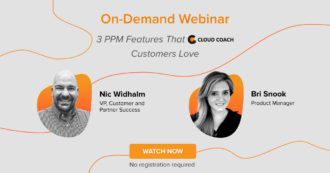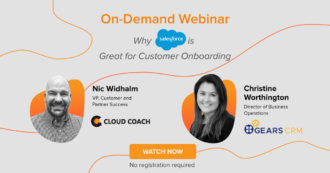 Webinar
Webinar
- Solutions
- Customer Onboarding
- Customer Success
- Professional Services Automation
- Project Management
- Project Portfolio Management
-
Solutions
-
Features
- Why Cloud Coach
- Customers
-
Resources

In any competitive business environment, retaining customers is critical for long-term success. Customer retention is the process of keeping customers satisfied and loyal to your company’s products or services, resulting in repeat business, referrals, and increased revenue. It is far more cost-effective to retain customers than to acquire new ones, making customer retention critical for B2B organizations and B2C organizations alike.
Effective B2B customer retention management requires clear goals and metrics for measuring progress towards those goals. Customer retention metrics are quantitative and qualitative measurements that help businesses understand the effectiveness of their customer retention strategies. These metrics provide insights into customer behavior, preferences, and satisfaction levels, allowing businesses to identify areas for improvement and optimize their retention efforts.
Customer retention rate (CRR) is one of the most foundational customer retention rate KPIs. It measures the percentage of customers who continue to do business with your company over a given period of time. A high average retention rate indicates that your company is successfully retaining customers, while a low CRR indicates that your customers are frequently leaving — which is typically symptomatic of low customer satisfaction. Comparing your company’s retention rate with the industry average can also help you identify opportunities for improvement and provide a context for interpreting your CRR.
To maximize customer retention, B2B businesses can develop comprehensive customer retention strategies that utilize informative retention metrics. TIn this article, we will explore best practices for measuring and managing customer retention at B2B organizations, discuss the importance of customer retention, and share strategies for managing retention.
Why Customer Retention Is Important
Customer retention is a critical component of the long-term success of practically any B2B company. Maintaining a loyal and satisfied customer base is essential for building a positive reputation, increasing revenue, and reducing expenses. There are several reasons why customer retention is important for B2B companies.
First, customer retention is more cost-effective than customer acquisition. Retaining existing customers requires less investment in marketing and sales efforts, as these customers already have a relationship with the company and are more likely to make repeat purchases. This usually leads to higher profits and better ROI.
Second, loyal customers are more likely to provide positive referrals and recommendations to others in their network. Word-of-mouth marketing is one of the best ways for B2B companies to build credibility with potential customers.
Third, a high customer retention rate indicates positive customer satisfaction levels and strong customer loyalty. Customers who continue to do business with your company over a long period of time likely have a more favorable perception of your products, services, and brand. Loyal customers lead to increased customer lifetime value and a stronger customer base overall.
The importance of customer retention for B2B companies cannot be overstated. Effective retention efforts are essential for building a strong reputation, increasing revenue, reducing costs, and maintaining a loyal customer base.
ADDITIONAL LINKS
Customer Retention Management
B2B organizations can use a variety of systems and tools to help manage and improve customer retention. One of the best tools for managing customer retention is customer relationship management (CRM) software. You can use CRM software to track customer behavior, preferences, and satisfaction levels, allowing your business to identify opportunities for improvement more efficiently and optimize retention efforts. Salesforce is an example of a leading CRM provider.
CRM software can provide a central repository for customer data, making it easy for businesses to track interactions and transactions across various touchpoints. This enables you to gain a better understanding of your customers’ needs and preferences, which can inform the development of more targeted retention strategies.
Another tool that B2B organizations can use to improve customer retention is customer feedback surveys. Simple surveys can be great for gathering insights into customer satisfaction levels, identifying areas for improvement, and addressing any issues that may be impacting retention.
Segmenting customers is a great way to personalize your retention strategies. By grouping customers based on their behaviors, preferences, and needs, you can tailor your retention efforts to specific customer segments, which is often more impactful than a one-size-fits-all approach.
You can also try using loyalty programs to incentivize repeat business and increase customer retention. Loyalty programs offer customers rewards, discounts, or exclusive access to products or services in exchange for repeat business or referrals, which can help to improve long-term customer loyalty and retention.
Customer Retention Statistics
Measuring customer retention statistics is essential for understanding the effectiveness of your retention efforts. Some key B2B customer retention statistics include customer churn rate, customer lifetime value, and customer satisfaction level.
Churn RATE
Customer churn rate is a crucial metric for measuring customer retention. The customer churn rate formula divides the number of customers your company lost during a specific period of time by the total number of customers your company had at the beginning of that period of time. This metric provides insight into the rate at which customers are leaving your business.
Customer Lifetime Value
Customer lifetime value (CLTV) is another important metric for measuring customer retention. CLTV is a measure of the total amount of revenue a customer is expected to generate over the course of their relationship with your company. By calculating CLTV, you can identify high-value customers and prioritize their retention efforts accordingly.
Customer Satisfaction
Customer satisfaction levels are also critical for understanding customer retention. You can measure customer satisfaction levels using metrics such as net promoter score (NPS), customer effort score (CES), or customer satisfaction score (CSAT). These metrics provide insight into customers’ perceptions of your company, allowing you to tailor your retention efforts accordingly.
What Is a Good Customer Retention Rate?
A good customer retention rate varies greatly by industry, which makes the question “what is the average customer retention rate?” rather difficult to answer without additional context. Average customer retention rate depends heavily on factors such as the nature of the product or service, the level of competition, and customer expectations. The best way to determine an accurate benchmark is to research customer retention rate examples in your industry.
How To Measure Customer Retention Rate
There are several ways for B2B companies to measure customer retention rate, including calculating the customer churn rate, using the customer retention rate formula, or using a retention rate calculator.
The simplest way to calculate your organization’s customer retention rate is by dividing the number of customers you retained during a given time period by the number of customers you had at the beginning of the same time period and multiplying by 100. (Disregard the number of customers you’ve acquired during the given time period, since you’re measuring existing customers kept, not new customers gained.)
Another common method for measuring customer retention rate is to calculate your business’s customer churn rate. This is essentially a way of looking at your customer retention rate from a different perspective, since your churn rate will always be the opposite of your retention rate. For example, if your churn rate for the past month was 20%, you know your retention rate was 80% (20% of customers lost means 80% of customers kept).
You can also identify your organization’s customer retention rate by using a customer retention rate calculator. You can find these calculators in many places online. Retention rate calculators are designed to help businesses calculate their retention rates accurately based on data such as the number of customers at the beginning of the time period in question, the number of customers lost during that time period, and the total revenue the company generated during that time period.
B2B Retention Metrics
While some customer retention metrics apply nearly universally to all kinds of business, such as B2C retail or ecommerce, there are some specific metrics that are specifically relevant to B2B companies.
One key B2B retention metric is customer lifetime value (CLTV), which measures the total amount of revenue a customer is expected to generate over the course of their relationship with your company. While this metric is not irrelevant for B2C organizations, it’s far more important for B2B companies because they often maintain longer-term relationships with customers and derive ongoing value from cultivating these relationships — not from just a single sale.
Another crucial B2B retention metric is customer acquisition cost (CAC), which measures the cost of acquiring a new customer. This metric is especially relevant for B2B companies because they typically have longer sales cycles and higher touchpoints than B2C companies do, which can inflate acquisition and onboarding costs.
Customer Retention Examples
Business leaders who want to learn more about B2B customer retention can gain better insights into their customer retention strategies and metrics in several ways. Here are a few methods business leaders can use to learn more about B2B customer retention:
Research Industry Benchmarks and Best Practices
Start by researching benchmarks and best practices for customer retention in your industry, specifically. Studying customer retention metrics examples can provide insights into which metrics are most important to track, as well as what kind of retention rates you should be striving to match or exceed.
Analyze Internal Retention Metrics
Of course, you should always analyze your own internal retention metrics to gain insights into which areas are successful and which areas need improvement. Remember to track metrics such as customer lifetime value, customer retention rate, and customer satisfaction.
Learn From Case Studies and Success Stories
You can also learn from case studies that share successful customer retention examples from other organizations. Learning about how other companies have implemented customer retention strategies can provide insight into what might work or not work for your own organization’s retention efforts.
The best ways to learn more about B2B customer retention include researching industry benchmarks and best practices, analyzing your own retention metrics, and learning from successful retention strategy examples. By taking a data-driven approach and proactively working to improve your organization’s customer retention strategy, you can increase customer loyalty and drive long-term growth for your business.
Helpful Resources
See Cloud Coach In Action
We’d be happy to provide a bespoke 1:1 demo on how Cloud Coach can benefit for your business.























